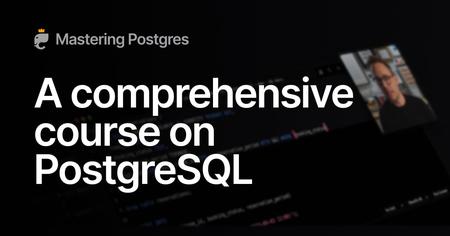English | MP4 | AVC 1920×1080 | AAC 44KHz 2ch | 118 Lessons (16h 14m) | 6.58 GB
Learn Postgres in the best way possible. Mastering Postgres is a comprehensive video course that will help you level up your applications and your career.
Your application is only as fast as your slowest query regardless of what language, framework, or hosting platform you choose. Mastering Postgres is a comprehensive video course that will help you level up your applications and your career.
You’ll deeply understand the core principles of PostgreSQL through real-world examples. Get to know the many data types Postgres offers and when to use them, and more importantly, when not to use them. You’ll understand how indexes work, how to improve your indexes and keep your database running as efficiently as possible.
What we’ll cover
This course is designed to take you from beginner to expert in Postgres. You’ll learn everything you need to confidently use Postgres in large-scale applications with demanding workloads.
Table of Contents
1 Introduction to the course
2 Overview of course structure
3 Postgres vs. everyone
4 The psql CLI
5 Introduction to schema
6 Integers
7 Numeric
8 Floating point
9 Storing money
10 NaNs and infinity
11 Casting types
12 Characters types
13 Check constraints
14 Domain types
15 Charsets and collations
16 Binary data
17 UUIDs
18 Boolean
19 Enums
20 Timestamps
21 Timezones
22 Dates and times
23 Intervals
24 Serial type
25 Sequences
26 Identity
27 Network and mac addresses
28 JSON
29 Arrays
30 Generated columns
31 Text search types
32 Bit string
33 Ranges
34 Composite types
35 Nulls
36 Unique constraints
37 Exclusion constraints
38 Foreign key constraints
39 Introduction to indexes
40 Heaps and CTIDs
41 B Tree overview
42 Primary keys vs. secondary indexes
43 Primary key types
44 Where to add indexes
45 Index selectivity
46 Composite indexes
47 Composite range
48 Combining multiple indexes
49 Covering indexes
50 Partial indexes
51 Index ordering
52 Ordering nulls in indexes
53 Functional indexes
54 Duplicate indexes
55 Hash indexes
56 Naming indexes
57 Introduction to explain
58 Explain structure
59 Scan nodes
60 Costs and rows
61 Explain analyze
62 Introduction to queries
63 Inner joins
64 Outer joins
65 Subqueries
66 Lateral joins
67 ROWS FROM
68 Filling gaps in sequences
69 Subquery elimination
70 Combining queries
71 Set generating functions
72 Indexing joins
73 Introduction to advanced SQL
74 Cross joins
75 Grouping
76 Grouping sets_ rollups_ cubes
77 Window functions
78 CTEs
79 CTEs with window functions
80 Recursive CTE
81 Hierarchical recursive CTE
82 Handling nulls
83 Row value syntax
84 Views
85 Materialized views
86 Removing duplicate rows
87 Upsert
88 Returning keyword
89 COALESCE generated column
90 Introduction to full text search
91 Searching with LIKE
92 Vectors_ queries_ and ranks
93 Websearch
94 Ranking
95 Indexing full text search
96 Highlighting
97 Intro to JSON
98 JSON vs JSONB
99 Validating JSON
100 Creating JSON objects + arrays
101 JSON extraction
102 JSON containment
103 JSON existence
104 JSON recordset
105 Updating JSON
106 Indexing JSON parts
107 GIN index
108 Intro to pgvector
109 Vector embedding columns
110 Find related articles
111 Upsert vector embedding
112 Semantic search
113 Other operators
114 Vector indexes
115 Thank you
116 Heroku’s glory days & Postgres vs the world (with Craig Kerstiens)
117 Creating a Postgres platform with Monica & Tudor from Xata.io
118 Bootstrapping an email service provider (with Jesse Hanley)
Resolve the captcha to access the links!
